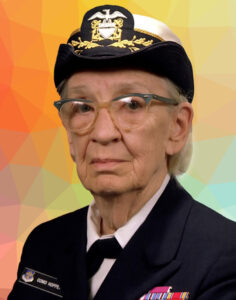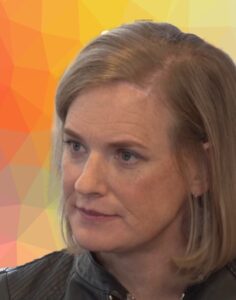Occupation
Computer Scientist, Mathematician, and United States Navy Rear Admiral
Birth/Death Dates
December 9, 1906 – January 1, 1992
Summary
Grace Hopper was a pioneer of computer programming and the first to devise the theory of machine-independent programming languages. Others later expanded upon the FLOW-MATIC programming language she created using this theory to create COBOL, an early high-level programming language still used today.
Educational Background
Vassar College (BA)
Yale University (MS, Ph.D.)
During her lifetime, Hopper was awarded 40 honorary degrees from universities worldwide.
Struggles this Innovator Overcame
In 1949, while employed by the Eckert–Mauchly Computer Corporation (EMCC), Hopper worked on the team developing the UNIVAC I. The UNIVAC I (Universal Automatic Computer I) was the first general-purpose electronic digital computer design for business applications produced in the United States. Hopper recommended the development of a new programming language that would allow programs to be written in English and then translated into machine code by computers. Unfortunately, this idea was ahead of its time and was initially turned down because “computers didn’t understand English.” It would be three years before it was accepted.
Remington Rand later acquired EMCC and completed the UNIVAC. While serving as Remington Rand’s UNIVAC director of Automatic Programming Development, Hopper developed a program known as the A compiler. The first version, the A-0 system (developed in 1951 and 1952 for the UNIVAC I), was an early compiler-related tool for electronic computers. Hopper’s A-0 system translated mathematical notation into machine code.
Problems this Innovator Solved
Hopper believed that because it is easier for most people to write an English statement than to use symbols, data processors should be able to write programs in English and rely on computers to translate their English words into machine code. She reasoned that manipulating symbols was easy for mathematicians but not for data processors and noted that skilled symbol manipulators were more likely to become professional mathematicians than data processors. Hopper developed a program known as the compiler A-0, which translated mathematical notation into machine code. That was the beginning of COBOL, a compiled English-like computer programming language for data processors. Developed in 1959 by CODASYL, COBOL was partly based on the FLOW-MATIC programming language designed by Hopper. COBOL is still used today in data processing.
How this inventor changed the world (or at least their corner of it)
In 1959, Hopper participated in the CODASYL consortium and guided the creation of a machine-independent programming language. This led to the COBOL language, which was inspired by her idea of a programming language based on English words.
Lasting changes from this inventor’s work or how they trailblazed
Hopper invented the English-like data processing language FLOW-MATIC, which inspired the COBOL programming language still used today in data processing.
While Hopper worked on the Mark II Computer at Harvard University in 1947, her associates discovered a moth impeding the computer’s operation. After they extracted it, the insect was affixed to a log sheet with the notation, “First actual case of bug being found.” While neither she nor her crew members mentioned the exact phrase “debugging” in their log entries, the case is held as a historical instance of “debugging” a computer. Hopper is credited with popularizing the term in computing.
President Obama posthumously awarded the Presidential Medal of Freedom to Hopper on November 22, 2016.
https://en.wikipedia.org/wiki/Grace_Hopper
https://en.wikipedia.org/wiki/UNIVAC_I
https://en.wikipedia.org/wiki/A-0_System
https://en.wikipedia.org/wiki/COBOL






